| |||||
| Decades: | |||||
|---|---|---|---|---|---|
| See also: | Other events of 1980 Years in Iran | ||||
Events from the year 1980 in Iran.
| |||||
| Decades: | |||||
|---|---|---|---|---|---|
| See also: | Other events of 1980 Years in Iran | ||||
Events from the year 1980 in Iran.

The Iran–Iraq War, also known as the First Gulf War, was an armed conflict between Iran and Iraq that lasted from September 1980 to August 1988. Active hostilities began with the Iraqi invasion of Iran and lasted for nearly eight years, until the acceptance of United Nations Security Council Resolution 598 by both sides. Iraq's primary rationale for the attack against Iran cited the need to prevent Ruhollah Khomeini—who had spearheaded the Iranian Revolution in 1979—from exporting the new Iranian ideology to Iraq. There were also fears among the Iraqi leadership of Saddam Hussein that Iran, a theocratic state with a population predominantly composed of Shia Muslims, would exploit sectarian tensions in Iraq by rallying Iraq's Shia majority against the Baʽathist government, which was officially secular and dominated by Sunni Muslims. Iraq also wished to replace Iran as the power player in the Persian Gulf, which was not seen as an achievable objective prior to the Islamic Revolution because of Pahlavi Iran's economic and military superiority as well as its close relationships with the United States and Israel.
This is a list of aviation-related events from 1988.
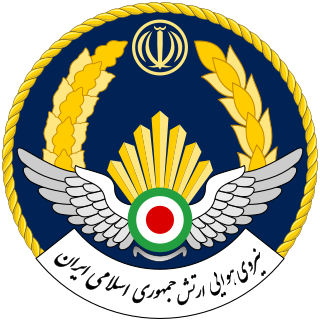
The Islamic Republic of Iran Air Force is the aviation branch of the Islamic Republic of Iran Army. The present air force came into being when the Imperial Iranian Air Force was renamed in 1979 following the Iranian Revolution. The IRIAF was heavily involved in the Iran–Iraq War, carrying out major operations like Operation Kaman 99, Operation Sultan 10, the H-3 airstrike, and the first attack on a nuclear reactor in history, Operation Scorch Sword. As a result of eight years of aerial combat in that conflict, the IRIAF has the second highest claimed number of fighter aces in the region, exceeded only by the Israeli Air Force; as many as seven IRIAF pilots claimed more than six kills, mostly achieved in the F-14 Tomcat. Veterans of the Iran–Iraq War would go on to form the core of the IRIAF command.

The Iraqi Armed Forces are the military forces of the Republic of Iraq. They consist of the Ground forces, the Army Aviation Command, the Iraqi Air Force, the Air Defence Command and the Iraqi Navy. Along with these primary service branches, there exists the Iraqi Counter Terrorism Service and the Popular Mobilization Forces. The Prime Minister of Iraq acts as the commander-in-chief according to Article 78 of the constitution of Iraq. The president of Iraq according to Article 73 of the constitution is the ‘high command’ for ceremonial and honorary purposes, such as approving the appointment of the chief of the general staff. The armed forces are administered by the Ministry of Defence (MoD).

The Iranian Navy traditionally located in the shallow waters of the Persian Gulf, has always been the smallest of the country's military forces. An Iranian navy in one form or another has existed since Achaemenid times in 500 BC. The Phoenician navy played an important role in the military efforts of the Persians in late antiquity in protecting and expanding trade routes along the Persian Gulf and Indian Ocean. With the Pahlavi dynasty in the 20th century that Iran began to consider building a strong navy to project its strength into the Persian Gulf and Indian Ocean. In more recent years, the country has engaged in domestic ship building industries in response to the western-backed Iraqi invasion of Iran, which left it without suppliers during an invasion.
The Grumman F-14 Tomcat has served with the United States Navy and the Imperial Iranian Air Force, then the Islamic Republic of Iran Air Force after 1979. It operated aboard U.S. aircraft carriers from 1974 to 2006 and remains in service with Iran. In-depth knowledge of its service with Iran is relatively limited.
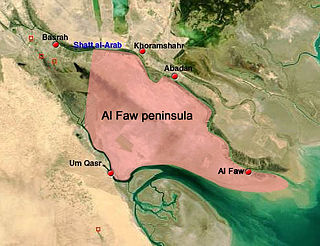
The First Battle of al-Faw was a battle of the Iran–Iraq War, fought on the al-Faw peninsula between 10 February and 10 March 1986. The Iranian operation is considered to be one of Iran's greatest achievements in the Iran–Iraq War. The Iranians were able to capture the al-Faw peninsula, cutting off Iraqi access to the Persian Gulf in the process; this in turn hardened Iraqi attitudes to prosecute the war. The Faw peninsula was later recaptured by Iraqi forces near the end of the war.

The Second Battle of al-Faw (also known as the Operation Ramadan Mubarak (Blessed Ramadan), fought on 17 April 1988, was a major battle of the Iran–Iraq War. After their defeat at the First Battle of al-Faw two years earlier, the newly restructured Iraqi Army conducted a major operation to clear the Iranians out of the peninsula.

Operation Samen-ol-A'emeh was an Iranian offensive and operation in the Iran–Iraq War between 27–29 September 1981 where Iran broke the Iraqi Siege of Abadan. The operation was carried out by the Iranian army joined by the Islamic Revolutionary Guard Corps.

The Iranian Armed Forces, officially the Islamic Republic of Iran Armed Forces, are the combined military forces of Iran, comprising the Islamic Republic of Iran Army (Artesh), the Islamic Revolutionary Guard Corps (Sepah) and the Law Enforcement Command (Faraja).

This is a timeline of events that stretched over the period of World War II in 1941, marked also by the beginning of Operation Barbarossa on the Eastern Front.

The First Battle of Khorramshahr was a major battle in the Iran–Iraq War, beginning shortly after the Iraqi invasion of Iran in September 1980. Amidst the gruelling urban warfare in and around the city, Khorramshahr came to be referred to by the Iranians as Khuninshahr, as both sides had suffered heavy casualties in combat. It was the single largest urban battle of the Iran–Iraq war.

Operation Tawakalna ala Allah were a series of five highly successful Iraqi offensives launched in April 1988 and lasting until July 1988. Iraq had originally only intended to retake the al-Faw peninsula it had lost to Iran, but following the battles' extraordinary success due to the complete collapse of the Iranian troops present, the Iraqi command decided to expand the battle into a larger offensive campaign, ultimately leading to the expulsion of all Iranian forces present within Iraq and subsequent renewed invasion of Iran.
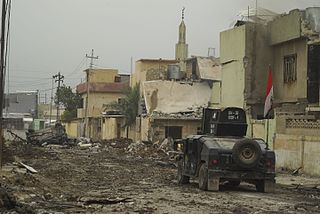
Many states began to intervene against the Islamic State, in both the Syrian Civil War and the War in Iraq (2013–2017), in response to its rapid territorial gains from its 2014 Northern Iraq offensives, universally condemned executions, human rights abuses and the fear of further spillovers of the Syrian Civil War. These efforts are called the war against the Islamic State, or the war against ISIS. In later years, there were also minor interventions by some states against IS-affiliated groups in Nigeria and Libya. All these efforts significantly degraded the Islamic State's capabilities by around 2019–2020. While moderate fighting continues in Syria, as of 2024, ISIS has been contained to a manageably small area and force capability.
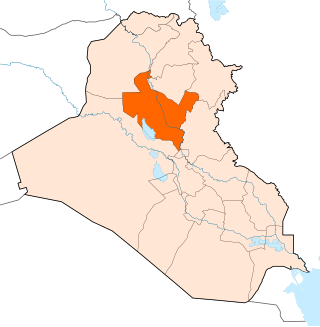
The siege of Amirli was a siege of the predominantly Shi'ite Turkmen town of Amirli in Iraq by the Islamic State of Iraq and the Levant (ISIL) during the War in Iraq. The town was besieged by ISIL forces for 50 days from June 2014, lacking access to food, electricity, and water. Most of the residents are Shia Turkmen, who had organized local self-defense militias to fight against ISIL. On August 31, the Iraqi military reportedly broke the siege and entered the town. It has been described as "Iraq's biggest victory against ISIS", as of September 2014.

Operation Shader is the operational code name given to the contribution of the United Kingdom in the ongoing military intervention against the Islamic State of Iraq and the Levant. The operation involves the British Army providing ground support and training to allied forces fighting against ISIL, the Royal Air Force providing humanitarian aid airdrops, reconnaissance and airstrikes, and the Royal Navy providing reconnaissance and airstrikes from the UK Carrier Strike group and escort to allied carrier battle groups.
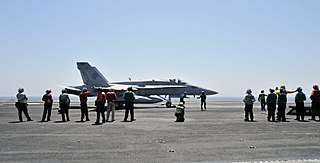
On 15 June 2014 U.S. President Barack Obama ordered United States forces to be dispatched in response to the Northern Iraq offensive of the Islamic State (IS), as part of Operation Inherent Resolve. At the invitation of the Iraqi government, American troops went to assess Iraqi forces and the threat posed by ISIL.

The Iranian intervention in Iraq has its roots in the post-2003 invasion of Iraq by the United States and its allies, when the infrastructure of the Iraqi armed forces, as well as intelligence, were disbanded in a process called "de-Ba'athification" which allowed militias with close ties to Tehran to join the newly reconstituted army.

On 14 September 2015, the Syrian Arab Army (SAA) – in cooperation with the National Defence Forces (NDF) and the Al-Ba'ath Battalion – launched a fresh offensive inside the Aleppo Governorate's southeastern countryside in order to lift the Islamic State of Iraq and al-Sham's (ISIS) two-year-long siege of the isolated Kuweires Military Airbase. This offensive was later complemented by another effort starting mid-October further south, which would be aimed at cementing government control over the main logistical route to Aleppo from central Syria.